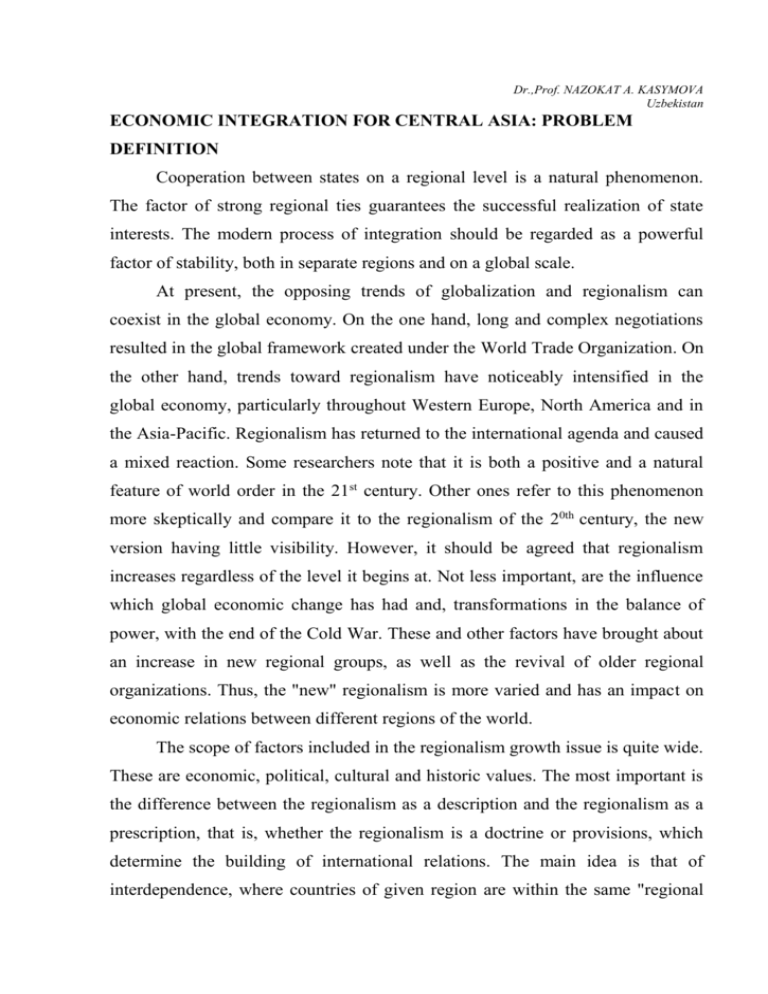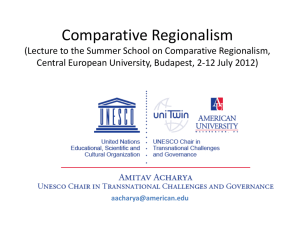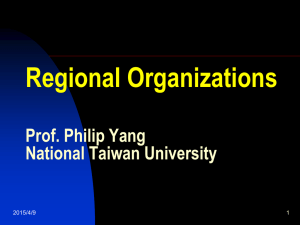PROBLEMS AND PROSPECTS OF CENTRAL ASIAN
advertisement

Dr.,Prof. NAZOKAT A. KASYMOVA Uzbekistan ECONOMIC INTEGRATION FOR CENTRAL ASIA: PROBLEM DEFINITION Cooperation between states on a regional level is a natural phenomenon. The factor of strong regional ties guarantees the successful realization of state interests. The modern process of integration should be regarded as a powerful factor of stability, both in separate regions and on a global scale. At present, the opposing trends of globalization and regionalism can coexist in the global economy. On the one hand, long and complex negotiations resulted in the global framework created under the World Trade Organization. On the other hand, trends toward regionalism have noticeably intensified in the global economy, particularly throughout Western Europe, North America and in the Asia-Pacific. Regionalism has returned to the international agenda and caused a mixed reaction. Some researchers note that it is both a positive and a natural feature of world order in the 21st century. Other ones refer to this phenomenon more skeptically and compare it to the regionalism of the 20th century, the new version having little visibility. However, it should be agreed that regionalism increases regardless of the level it begins at. Not less important, are the influence which global economic change has had and, transformations in the balance of power, with the end of the Cold War. These and other factors have brought about an increase in new regional groups, as well as the revival of older regional organizations. Thus, the "new" regionalism is more varied and has an impact on economic relations between different regions of the world. The scope of factors included in the regionalism growth issue is quite wide. These are economic, political, cultural and historic values. The most important is the difference between the regionalism as a description and the regionalism as a prescription, that is, whether the regionalism is a doctrine or provisions, which determine the building of international relations. The main idea is that of interdependence, where countries of given region are within the same "regional Dr.,Prof. NAZOKAT A. KASYMOVA Uzbekistan boat" in ecologic, strategic and economic terms. It is emphasized without fail, that they have to limit their national egoism and look for new cooperation ways. All scientific and political discussions clearly state that regionalism in fact is necessary and important process. It is possible to define five basic categories of the regionalism concept. This is an analytical method and correlations among these categories represent the theory and practice of modern regionalism: regionalization; regional consciousness and identification; regional transnational cooperation; regional economic integration; regional cohesion.1 The issues of defining different degrees of integration always play especial part in theoretical discussion on regional integration. In economic terms, regional integration can be examined as eliminating the artificial barriers to free trade between participating countries and harmonization of different methods of economic development assistance. Member-countries harmonize their economic policies with one another, in economic and political spheres, during the process of integration, and let the market to play the central role during this process.2 Political science points to three main reasons for the creation of regional trade blocks. First, the general interest of states in this form of cooperation due to geographical proximity and perceived opportunities for the formulation of common economic, social and cultural interests. Second, ideological considerations and motives, which, for instance, can be a facilitator of the idea of a constitutional association. Third, rational choice, which simultaneously means a transition to economic aspects. When a cost and benefits analysis is conducted on Касымова Н. Региональная интеграция: теоретические аспекты.// Международные отношения.Ташкент:УМЭД, 2005. - №2. 2 Joseph Nye (ed.) International Regionalism. - Boston:Little, 1968.-p.xii. 1 Dr.,Prof. NAZOKAT A. KASYMOVA Uzbekistan this membership, if the benefits of membership are shown to outweigh the costs, it speeds-up regional integration processes.3 Fourth reason is national security, regional trade block are created with the hope of discouraging war between member countries. There is a model that provides for five different stages of regional integration: free trade area or zone; customs union; common market; economic union; political union. This model is being used in the European integration process. Furthermore, it was a model for economic integration widely used among developing countries. However, in many cases this approach turned out to be misleading, because these states did not take into consideration the pre-conditions necessary for successful economic integration (e.g., their unique economic and political systems and historical differences). It is possible to formulate three preconditions for successful economic and political integration based on the world experience: Existence of similar economic structures and industrialization processes. If there are enormous differences in economic structures and the level of industrial output in each country in the region, the risk of direct losses posses a threat. If these losses occur on a long-term basis, they can lead to the stagnation or even collapse of the integration process; 3 De Melo, Jaime; Montenegro, Claudio; Panagariya, Arvind. Regional Integration, Old and New. World Bank Policy Research Working Papers Series No.985. Washington, DC: The World Bank, 1992. Dr.,Prof. NAZOKAT A. KASYMOVA Uzbekistan Common social and political ideologies. It is very important when participating states share common social and political goals, and exhibit willingness to compromise. In addition, long-term political stability is a pre-condition for overcoming opposing viewpoints during the course of the process; Refusal to pursue over-ambitious goals and policies of progressive development, where new forms of mutual consultation and cooperation are worked out. First of all, these forms need to be oriented toward practical decisions. In other words, successful integration processes need time and patience. Primarily, it is necessary to direct states’ efforts toward cooperation on concrete projects, in order to establish the pre-conditions for further integration of separate economies or as the basis for greater goals. It is difficult to draw a line of division between the economic and political aspects of regional integration. The main characteristic of «new» regionalism is that it is multifaceted. Extensive political and security goals are achieved through economic integration. Moreover, even if regionalism is based upon economic goals, it is unlikely to prove an existence of serious differences (divergences) in other questions (fields). The Soviet era’s economic, political and military linkages in Central Asia have apparently been broken up. The region was divided into five republics at will during Stalin’s time, and this unleashed a potential for international tensions and distrust in spite of the common origins, religion and culture of the local nations. Such tensions grew out of numerous territorial disputes; the competition for control of natural resources, particularly over the control of the water management system; border conflict; trade policy competition, particularly in respect to trade and payments. Solutions to these problems should be Dr.,Prof. NAZOKAT A. KASYMOVA Uzbekistan individualized solutions, the activity of numerous actors and institutions, and may require the intervention of a third party (outside actors). The independence of Central Asian states has opened up enormous prospects for economic development, along with the possibility of finally being recognized as worthy and equal actors in the international community. Central Asian countries have been seeking to establish mutually beneficial and bilateral relations with all countries, in order to gain assistance and cooperation in creating a more economically prosperous and stable Central Asia. Central Asian states have deep historical, cultural and spiritual roots that unite its people and form the basis for close regional cooperation. Central Asia as a region has great potentials and prospects for cooperation and integration. The idea of integration in the changing post-Soviet context, however, needs to be concretely conceptualized to help discover avenues of inter and intra-state ties. And economic and social aspects play their interdependent role in determining the shape of things to come and also the extent of integration to be established. Perhaps the necessity for some form of economic union among the region’s countries is not so obvious at present, but integration is of great importance for the region’s future. However, this must be an evolutionary process, based on the goodwill of member-states, and the realization of the benefits and need for the creation of an economic alliance. A Central-Asian economic alliance will allow for the creation of additional economic advantages for all member states, and will help bring about dynamic economic growth along the way. The advantages of creating such an alliance may include: the region is able to produce enough energy, mineral and agricultural resources for its inhabitants without importing these natural resources from outside the region; powerful export potential; Dr.,Prof. NAZOKAT A. KASYMOVA Uzbekistan advantageous geopolitical position in the center of Asia, being located between Russia and Europe, on the one hand, and China, South-East Asia, India, Pakistan and Middle Eastern countries, on the other hand; high production potential, which is dependent upon cooperation and joint investments to organize highly competitive goods production with high degrees of readiness during short periods; increased value-added of human capital, due to a highly-educated and highly-skilled work force; low cost of labor; possibility for the most rational use of water, like other natural resources, and hence ecological security achievements; high scientific and technological potential. Trends in regional cooperation in Central Asia are based on the understanding that these states really do share a lot of common problems. Therefore, the development of integration processes is defined by shared economic, social and demographic problems. It is possible to point out four major obstacles to the resolution of these problems that are shared by all 5 states: Radical restructuring of inefficient production-commercial structures inherited from the past, destruction of disproportion between mining and processing branches, creation of diversified regional economic complexes, fitted to the world’s economic standards; Measures to strengthen and diversify exports, and use of the profits received from diversification of exports to finance structural adjustment and social programs; Assurance of full employment, reduction in level of unemployment and the creation of a social safety net for those who lose their jobs; Dr.,Prof. NAZOKAT A. KASYMOVA Uzbekistan Agreement reached on the resolution of major ecological problems, first and foremost, the shrinking of the Aral Sea. Solutions to these problems depend on close cooperation among Central Asian countries. Only joint efforts can determine which issues are most pressing. The priority directions among these issues are ensuring regional economic and ecological security. Hence, the existing common economic space is being gradually transformed into a unified market economy, step-by-step. At present, a desire to cooperate and interact, via one form of integration or another, is becoming stronger. However, this is the integration of national economics on a new political and economic basis. Although the present economic position of Central Asian republics is unequal, this does not mean that there are fewer options for possibilities for economic integration, but on the contrary, it requires searching for their intensity. But it is necessary to stress, the processes for further internal integration of Central Asian states and their integration into the global economy will depend on the nature and depth of economic reforms in these republics, and on the countries’ readiness levels. However, steps toward regional integration of these republics not only reduce, but require joint efforts to search for ways for integration into the global economy. It requires closer cooperation with the already established economic alliances and communities of the global community. The interests of Central Asian countries determine their priorities. It is a priority for these countries to use their economic potential by speeding-up their social-economic development. It is necessary to maintain these economic relationships, by encouraging countries in this regional trade bloc to engage in the Dr.,Prof. NAZOKAT A. KASYMOVA Uzbekistan specialization of the production of those goods in which they have a comparative advantage vis-à-vis other regional trade blocs. It is possible to expand upon the priority directions for economic cooperation: Rational use of water resources and ensuring ecological security of the region. Uncoordinated usage of the water supply and pollution of rivers are serious issues which must be addressed immediately. Trade cooperation. The establishment of economic ties and a common market are the most important steps for the integration of Central Asian states. It is necessary to concentrate states’ efforts on creating a framework for the exchange of goods among different parts of the region. This work provides organizations with efficient trade cooperation. In prospect is the question of the formation of a free trade zone within Central Asia. Creation of a common agricultural market. It is important to preserve the traditional economic relationships on the delivery of agricultural products in these countries. Future prospects include specialization of these countries in the field of agricultural production. Efficient use of fuel and energy resources. Central Asia’s energy resources potential vastly exceeds those of other states. Their balanced, efficient use can and must become a basis for economic development, enabling CentralAsian states to be counted among the newly industrialized states of Asia. Production cooperation in order to produce competitive products with high degrees of readiness. Great prospects have opened up for the joint use and exporting of minerals and natural resources. Such cooperation can be realized by establishing relationships with IFIs and companies, or through the mutual participation in the stock market that are bounded by the united technological chain. Dr.,Prof. NAZOKAT A. KASYMOVA Uzbekistan Establishment of a unified transport system with export potential. The most important direction for economic integration is the development of a regional transport system within Central Asia. In order to benefit from the advantages of its geographical position, the region has to make long-term investments in transport network development, as opposed to short-term investments. This network will be more efficient if there is joint participation of all interested states. Establishment of modern communications and facilities. Communication development is one of the main conditions for the integration of the Central Asian region into the global economy. Development of a central bank, establishment of a monetary union. Creation of a Central Bank is the first and the most important step on the path toward the creation of a monetary union. It will serve to enhance the trade-economic cooperation of the region. Development of market infrastructure. The basis of economic integration is market relations between activity units of the region’s countries. It requires the development of a service sector, whose purpose is to support the activities of all market types, i.e. market infrastructure. Establishment of conditions for small business development. The creation of incentives for the rapid development of small and medium sized enterprises is in the interests of all Central Asian countries. Incentives for business development can include allowing for the free flow of capital. For example, Uzbekistan should quickly make its som convertible on the internal currency market, in order to allow for the free flow of capital. Other conditions which would encourage the development of SMEs would include subsidies provided to infant industries; venture capital for entrepreneurs to start up their business; tax breaks for foreign companies opening up operations in Central Asia. Dr.,Prof. NAZOKAT A. KASYMOVA Uzbekistan Scientific and technical cooperation. One of the most important problems of integration is the inefficient use of powerful joint intellectual potential, technologic breakout and creation of scientific and technological basis for the economic development of these states. One can imagine how the economic integration of Central Asian countries could open up broad possibilities for decisions on a variety of economic, social and ecological problems in this part of the world. Such integration is advantageous for all states in this region, and can become a factor in speeding up these countries’ levels of economic development. By establishing a common market, Central Asian states can participate as equal partners in other economic and trade alliances, exert their influence on the current economic and political processes in the world, and emerge as a guarantor of political stability in Eurasia. Moreover, the integration projects of Central Asian countries would involve much more than economic cooperation. There is a growing need to address political, humanitarian, information and regional security issues. There is a joint effort to make decisions on regional development. However as stated above, the achievement of these projects are determined by the structural reforms carried out in Central Asian economies and is dependent upon the socio-economic development of these countries. Some countries view regional integration as a threat to Uzbekistan’s or Kazakhstan’s hegemonic role; however, hegemony is a big political, economic, security and moral burden for any state in the region. Furthermore, Central Asian states have all the necessary political and legal instruments in order to oppose any attempts of over-domination by one of them. Integration is a non-violent process, and participators are able to withdraw from the union at will. Central Asian states are still active in their attempts to resolve problems of regional stability and security. It is only through the resolution of these issues that deep economic integration can be achieved. It doesn’t mean that security issues Dr.,Prof. NAZOKAT A. KASYMOVA Uzbekistan need to be resolved first before economic integration can occur, but it must be parallel process. Economic integration creates the conditions for national security via deep economic ties, which strongly discourage member countries of a regional trade bloc from going to various inter-state conflicts. The establishment of strong regional ties guarantees the successful transition of these states’ integration into the global economy. At the same time, globalization, economic interdependence and instant communication have limited the scope of national independence. But the influence of other states bordering Central Asia nevertheless plays an important role, as some of these states are not interested in its integration. In other words, the region is acquiring a new geopolitical status in the New World Order. Although complete political and economic integration is a long way down the road, our nations can continue down that path. Central Asian integration is complicated and long-come process, and its progress is dependent first and foremost upon region’s own efforts.








